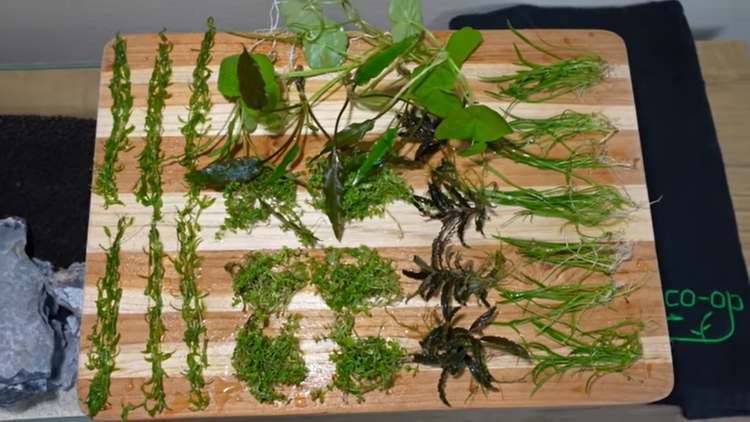Beginner's Guide: How to Plant Live Aquairum Plants
- Sep 17, 2023
- Anshika Mishra
- 167 0 0

Aquatic plants are the perfect addition to many aquariums. But, if you've just picked up a new plant, you may want to consider how to introduce it to the tank. Different aquarium plants have different needs, and using the correct planting technique can make all the difference.
This guide will show step-by-step ways of planting live plants in an aquarium.
Rhizome Plants
The most popular type of Rhizome plants includes:
- Anubias
- Java Fern
- Bolbitis
- Bucehalandar
They all have a Rhizome, which is a thick horizontal trunk. All the leaves and stems grow upwards while the roots grow downwards. The great thing about these plants is that you don't need any substrate to produce them. You can wedge them between rocks or mount them to decor.
Eventually, the plant's roots will grow and wrap around the hardscape. So it became difficult to remove. An even easier way to plant your Rhizome plant is to leave it in the plastic basket and leave it in the easy planter decoration.
Finally, if you want to plant them in your substrate, you can bury the roots if the Rhizome is not covered. They absorb nutrients from the water. So, feed them liquid fertilizer as needed.
Sword Plants
Swords are classified as a rosette plant, which means all the leaves grow out of the base of the plant in a circular pattern. Examples include the Amazon and Red Flame Swords. Using your finger, dig a hole in the substrate and bury the roots of the sword. Or you can use tweezers to push the plant roots into the substrate. Try not to cover the crown.
Swords are heavy root feeders, meaning they prefer to absorb nutrients via their roots. So, add root tabs if you're using an inert substrate or if your nutrient-rich substrate is depleted.
Cryptocoryne
Cryptocoryne, or Crypts, need substrates and root tabs to grow. Like Sword plants, you want to bury their roots while keeping the plant's brown above the ground.
Crypts are very prone to melting when introduced to a new aquarium. So, don't throw away your tombs if their leaves fall off. Fresh leaves start appearing once the plants get used to their new surroundings.
Grass Like
This category refers to Valisneria, micro sword, and other plants that propagate via runners or little horizontal stems that produce a plantlet at the end, eventually creating a long chain of connected plants.
Plant its roots in the substrate and don't convert the hearts of the leaves. Often, one pot comes with several individual plants, so plant them separately so there's little place between each one for growth.
These plants can quickly propagate to create a grass-like carpet in the foreground or a tall forest in the background if you like to spread the plant into another area or a new tank.
Mosses
Mosses like Java Moss and Christmas Moss are similar to Rhizome plants in that they don't require substrate and can be attached to hardscape via threads or glue.
Instead of being packaged in pots, they are sold already affixed to a mesh rectangle. Moss can also grow as a free-floating mass, which is excellent for colony breeding.
Stem Plants
These plants are known for growing vertically, with leaves coming out directly from the stem. To prepare the plants, remove the basket ring or rubber band around its base. Plant stems deeply into the ground. Let the substrate cover some of the bottom leaves. Don't plant them in a single bunch, but individually, with a bit of space in between so the roots have enough room to grow.
Use tweezers to plant them quickly, and if needed, wrap plant weights around the bottom to prevent them from floating away. If the stems have no leaves, some people will float at the surface until they develop roots and then plant them in the substrate.
Bulb Plants
The Banana plant, Dwarf Aquarium Lily, and Tiger Lotus are all plants that grow from a bulb or rubbers. Rinse the bulb to remove any rock, wool, or substrate covering it and place it on top of the substrate.
New roots and leaves will soon spread out the bulb. If there's no growth, turn the bulb over, as it may be upside down. They can grow tall and take nutrients from liquid fertilizer and root tabs.
Carpeting Plants
Many kinds of foreground plants and even mosses can be used to cover your tank. But this section specifically refers to short, dense carpeting plants with lots of tiny leaves and small roots, like the Monte Carlo.
Most websites recommend breaking the pot into tiny pieces. But you can also insert the whole pot into the substrate and allow the pan to carpet.
Floating Plants
It's the easiest plant to add to the tank: Frogbit, Duckweed, and even some species of stem plants. Place them on the surface, provide lots of liquid fertilizer and light, slow down the current, and don't let their leaves get too wet.






About author